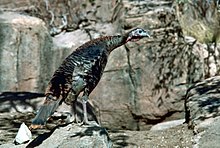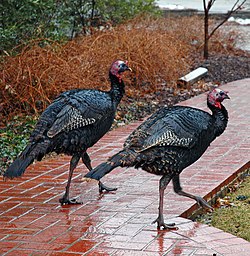Turkey (bird): Difference between revisions
No edit summary |
rv vandalism - unchecked for 20 minutes folks |
||
| Line 22: | Line 22: | ||
}} |
}} |
||
A '''turkey''' is either one of two species of large [[bird]]s in the genus '''''Meleagris'''''. Turkeys are classed in the [[Galliformes|gamebird]] order. Formerly, they were considered a distinct [[family (biology)|family]], '''Meleagrididae''', but more recently they were reclassified as a [[subfamily]] ('''Meleagridinae''') of the pheasants and their allies{{cn}}. As with many galliform species, the female is smaller than the male, and much less colourful. With their wingspans of 1.5-1.8 meters, the turkeys are by far the largest birds in the open forests in which they live, and are rarely mistaken for any other species. |
A '''turkey''' is either one of two species of large [[bird]]s in the genus '''''Meleagris'''''. Turkeys are classed in the [[Galliformes|gamebird]] order. Formerly, they were considered a distinct [[family (biology)|family]], '''Meleagrididae''', but more recently they were reclassified as a [[subfamily]] ('''Meleagridinae''') of the pheasants and their allies{{cn}}. As with many galliform species, the female is smaller than the male, and much less colourful. With their wingspans of 1.5-1.8 meters, the turkeys are by far the largest birds in the open forests in which they live, and are rarely mistaken for any other species. |
||
The two species are the [[North America]]n '''[[Wild Turkey]]''' (''M. gallopavo'') and the [[Central America]]n '''[[Ocellated Turkey]]''' (''M. ocellata''). |
The two species are the [[North America]]n '''[[Wild Turkey]]''' (''M. gallopavo'') and the [[Central America]]n '''[[Ocellated Turkey]]''' (''M. ocellata''). |
||
Revision as of 18:06, 20 November 2006
- This article is about the bird. For other uses, see Turkey (disambiguation).
| Turkeys | |
|---|---|

| |
| Wild Turkey, Meleagris gallopavo | |
| Scientific classification | |
| Kingdom: | |
| Phylum: | |
| Class: | |
| Order: | |
| Family: | |
| Subfamily: | Meleagridinae Gray, 1840
|
| Genus: | Meleagris Linnaeus , 1758 |
| Species | |
|
M. gallopavo | |
A turkey is either one of two species of large birds in the genus Meleagris. Turkeys are classed in the gamebird order. Formerly, they were considered a distinct family, Meleagrididae, but more recently they were reclassified as a subfamily (Meleagridinae) of the pheasants and their allies[citation needed]. As with many galliform species, the female is smaller than the male, and much less colourful. With their wingspans of 1.5-1.8 meters, the turkeys are by far the largest birds in the open forests in which they live, and are rarely mistaken for any other species.
The two species are the
The modern
Turkeys are widely hunted, particularly the Wild Turkey in North America. Unlike their domestic counterparts, the turkeys are wary and agile flyers.
Naming
When Europeans first encountered these species in the Americas, they incorrectly identified them with the

The names for the domesticated Turkey in other languages also frequently reflect its exotic origins, seen from an Old World viewpoint, and confusion about where it actually comes from. The many references to
- The native Nahuatl name of the Wild Turkey is guajolote (or an older spelling, xuehxolotl).
- In Castilian Spanish, it is called Pavo.
- In Turkish the bird is called hindi which means "from/related to India" as does French (poulet) d'inde ("(chicken) from India"), from which French dindon and Ido Dindo.
- In Catalan it is called gall dindi, literally meaning "Indian chicken".
- In Hebrew the turkey is called tarnegol hodu (תרנגול הודו), which literally means "Indian chicken" Coincidentally, the Hebrew word for India (hodu) is a homonym for "thanks," contributing to a popular misconception that the word's etymology connotes "Thanksgiving chicken."
- The Yiddishindik (אינדיק) all relating to India.
- In Maltese it is called dundjan (pronounced doonDYAHN), another, maybe not so obvious, reference to India.
- In Arabic it is called deek roumi (ديك رومي) meaning Roman Rooster or, less commonly, "Ethiopianbird."
- In Egyptian Arabic it is colloquially called the "Greek Bird"
- The Bahasa Indonesia (ayam) kalkun (ayam means "bird"); likewise Danish and Norwegian kalkun, Swedish kalkon, and Low German Kalkuun as well as Finnish kalkkuna and Papiamentokalakuna.
- In Malay it is called ayam belanda which literally means "Dutch chicken".
- In Portuguese the word for turkey is peru which also refers to the country Peru.
- In Greek it is gallopoula which means "French bird".
- In Bulgarian it is Пуйка (puijka) but a dialect version is Мисирка (misirka), which comes from the Arabic word for Egypt
- In Scottish Gaelicit is called cearc frangach, meaning "French chicken".
- In Italian it is called tacchino.
- In Japan the turkey is called shichimencho (七面鳥) and in Korea chilmyeonjo, both of which translate as "seven-faced bird". This is said to reflect the ability of the bird, particularly the male, to change the form of its face depending on its mood.
- In Chinese it is called huoji (火鸡) which means "fire chicken", named after the color of the head.
For names in other languages for the Wild Turkey, see list of names for the Wild Turkey.
Several other birds which are sometimes called "turkeys" are not particularly closely related: the

Asexual reproduction
Turkeys are notable for their ability, rare amongst higher species, to reproduce asexually. In the absence of a male, female Turkeys are known to produce fertile eggs. The individual produced is often sickly, and nearly always male. This behaviour can interfere with the incubation of eggs in Turkey farming[1].
Fossil turkeys
Many turkeys have been described from
In the modern genus Meleagris, a considerable number of species have been decribed, as turkey fossils are robust, fairly often found, and turkes show much variation among individuals. Many of these supposed fossil species are now considered
Turkeys known only from fossils:
- Meleagris sp. (Early Pliocene of Bone Valley, USA)
- Meleagris leopoldi (Late Pliocene of Cita Canyon, USA) - formerly Agriocharis
- Meleagris progenes (Rexroad Late Pliocene, Meade County, USA) - formerly Agriocharis
- Meleagris sp. (Late Pliocene of Macasphalt Shell Pit, USA)
- Meleagris anza (Early Pleistocene of San Diego County, USA)
- Meleagris californica (Late Pleistocene of SW USA) - formerly Parapavo/Pavo
- Meleagris crassipes (Late Pleistocene of SW North America)
See also
- Domesticated turkey
- North American Wild Turkey
- Central American Ocellated Turkey
References
- Olson, Storrs L. (1985): Section VIII.H.4.d. Meleagridinae. In: Farner, D.S.; King, J.R. & Parkes, Kenneth C. (eds.): Avian Biology 8: 118-119. Academic Press, New York.
Footnotes
- ^ Savage, Thomas F. (September 12, 2005). "A Guide to the Recognition of Parthenogenesis in Incubated Turkey Eggs". Oregon State University. Retrieved 2006-10-11.
- ^
Formerly Parapavo californica and initially described as Pavo californica or "California Peacock".
External links
- Turkey videos on the Internet Bird Collection
- Etymology of the word
